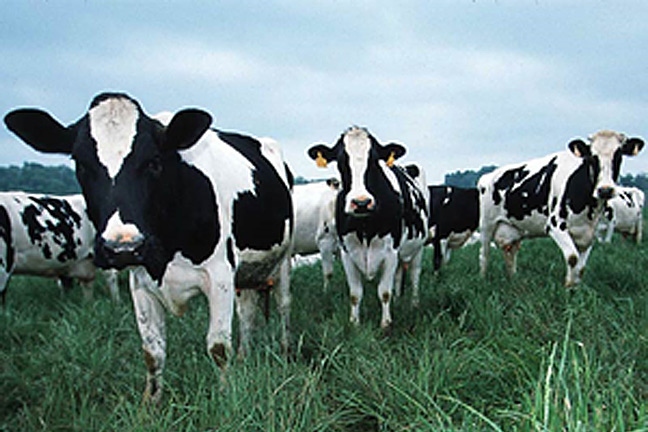
Agricultural News
California Milk Producers Call on Returning Congress to Pass Farm Bill
Mon, 10 Sep 2012 11:37:02 CDT

In the latest newsletter of the California Milk Producers Council, Rob Vandenheuvel penned the following opinion piece urging producers to contact their Congressmen to request quick passage of the 2012 Farm Bill.
After spending the five weeks back in their districts, the House of Representatives is returning to Washington, DC, with a major piece of legislation awaiting their action: the 2012 Farm Bill.
The Farm Bill is a comprehensive package of agriculture and nutrition policy proposals for the next five years. The U.S. Senate has already approved their version of the bill, and the House Agriculture Committee has approved their version. The next step in the process is for the full House of Representatives to vote on the House Ag Committee's version of the bill. Included in both the House and Senate bills is a package of reforms to the U.S. dairy safety net policies. Both bills would eliminate the Milk Income Loss Contract (MILC) and the Dairy Product Price Support (DPPSP) programs. Both bills would put in their place a two-pronged safety net program for U.S. dairy farmers. Those two parts of the proposal are the Dairy Producer Margin Protection Program (DPMPP) and the Dairy Market Stabilization Program (DMSP).
The DPMPP is a voluntary "margin protection" program that dairies can sign up for. It provides direct cash payments to dairymen during periods of time when on-the-farm margins are severely compressed or negative. The DMSP is a program that provides a direct incentive for dairies to temporarily cut back milk production when those on-the-farm margins reach severely compressed or negative levels. However, it should be noted that the DMSP only applies to dairies that decide to sign up for the government funded and subsidized DPMPP.
This newsletter has devoted a significant amount of space to why this two-pronged approach to Federal dairy policy is a vast improvement over the current policies that apply to our industry. We've written numerous pieces on why MPC and other dairy organizations around the country are so supportive of implementing this well-thought-out and wise policy.
With the U.S. House of Representatives coming back to Washington, DC to hopefully take up their version of the 2012 Farm Bill, it's important that dairy farmers know how our current situation might be different if this policy were in place.
The DMSP is a completely new approach to empowering the dairy producer sector to collectively take the steps necessary to bring milk production into better balance with demand. It represents a rational and quick-acting method of correcting an oversupply of milk, as opposed to our current methods of supply corrections that include "hoping that the heat or the drought will reduce production" or "hoping that my neighbor will go out of business so that our national production will be reduced." (Isn't it a pathetic statement for our industry that these are the main "tools" we have to bring about milk supply corrections??) However, while the DMSP is a valuable tool that is a critical part of the 2012 Farm Bill, for the purposes of this article, I'm going to focus only on the DPMPP.
As a reminder, the DPMPP provides two levels of margin protection:
• A government-funded "basic program" that makes direct payments to enrolled dairy farmers when the national "milk-price-minus-feed-cost" margins calculated in the program drop below $4.00 per hundredweight.
• A partially-subsidized "supplemental program" that allows dairies to customize their margin protection. This program includes a premium paid by the dairymen, but provides direct payments when "milk-price-minus-feed-cost" margins calculated in the program drop below a customized trigger (such as $5.00 per hundredweight or $6.00 per hundredweight, etc.)
Looking at the margin calculations in both the House and Senate Farm Bills (they have identical margin calculations), direct payments would have been made under the "basic program" for the months of May, June, July and August. For an average California dairy, milking 1,000 cows producing 65 pounds of milk per cow per day, those payments would have equaled $51,867 for those four months.
If that same 1,000-cow dairy had decided to enroll in the "supplemental program" and opted to provide margin protection up to $6.00 per hundredweight, the dairy would have had to pay an annual premium of $29,496 (in the House version of the bill) or $27,829 (in the Senate version of the bill). In return, both versions of the Farm Bill would have generated direct payments for the months of March, April, May, June, July and August. Collectively that average 1,000-cow California dairy would have received direct payments totaling $230,096 during those six months (an average of $2.22 per hundredweight). (How does that compare to the MILC payments your dairy received earlier this year-the payments that a 1,000 cow dairy "exhausted" in only one-and-a-half months?)
Clearly, the dairy reforms in the current House and Senate versions of the 2012 Farm Bill represent a huge improvement for California's dairies. It not only does a better job of protecting the margins of our dairy farmers (without discriminating against dairies due to size), but it also gives us a valuable tool (the DMSP) to help restore supply/demand balance. MPC is proud to stand side-by-side with organizations like Dairy Farmers of America and Land O'Lakes, who also represent many California dairy families, in supporting this much needed reforms.
We are urging all California dairy families to get active as the House of Representatives comes back into legislative session. Please pick up the phone ASAP and call your Congressman's office. Ask them to urge their House leadership to bring this much-needed reform to the House floor for a vote. The House of Representatives has scheduled only 8 more legislative "work days" before the current 2008 Farm Bill expires, so time is of the essence!
WebReadyTM Powered by WireReady® NSI
Top Agricultural News
More Headlines...



















